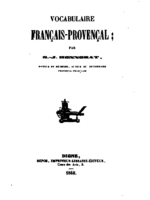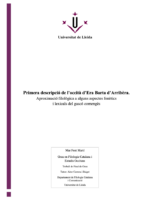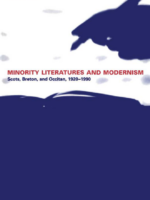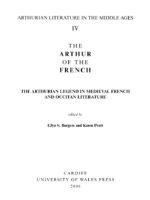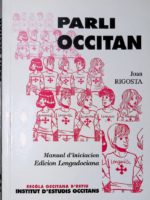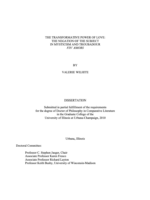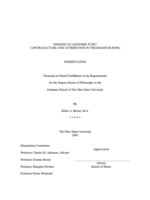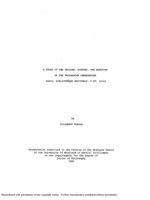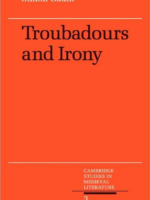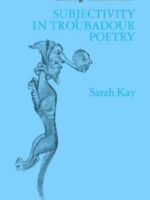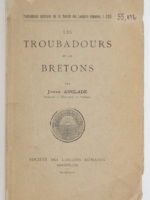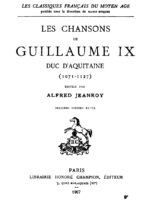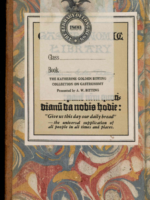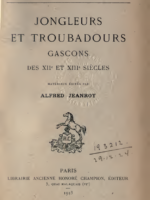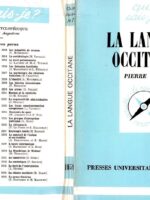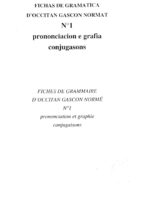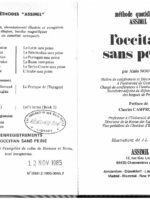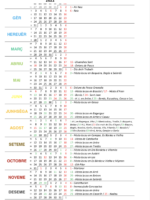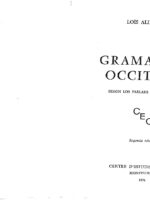Recommended Books
-
Primera descripció de l’occità d’Era Barta d’Arribèra
0,00 €Dins del domini gascó, i alhora reflectint la situació occitana general, hi ha una variació interna notòria entre les diferents varietats que omplen el territori. En aquest sentit, el comengès, que enclavem en el gascó pirinenc oriental (subdialecte que abasta una zona que comprèn la Vall d’Aran, l’àrea de La Varossa, el Comenge meridional i el Coserans), es diferencia d’una manera prou evident d’altres variants més occidentals, justament per la seua condició de parlar fronterer, situat en una zona interferencial, en paraules de Bèc (1968), entre el gascó i el llenguadocià. El treball que prossegueix mira de fer una descripció d’alguns aspectes fonètics i lexicals d’un dels municipis de parla comengesa, Era Barta d’Arribèra, localitzada estratègicament a pocs quilòmetres de Sent Gaudenç, capital històrica del Comenge i de l’antiga comarca del Nebosan.
-
Minority Literatures and Modernism: Scots, Breton, and Occitan, 1920-1990
0,00 €A quiet renaissance has been unfolding in certain parts of Europe – a renaissance of literature written in minority languages. In this book, William Calin explores the renaissance through an examination of twentieth-century works in Scots, Breton, and Occitan minority languages flourishing inside the borders of the United Kingdom and France.
For each of the three bodies of literature Calin considers major authors whose works include novels, poetry and plays, and shows that all three literatures have evolved in a like manner, repudiating their romantic folk heritage and turning instead to modern and postmodern concerns. Drawing on current critical theories in periodization, postcolonialism and cultural studies, Calin raises a range of comparative questions: Is there a common form of narrative prevalent in minority cultures that is neither realism nor metafiction? Is the minority-language theatre limited to plots treating past history and the rural present? What is the relationship between the minority literature and literature in the national language? What kind of history should be written on the literatures of Scotland, Brittany and the South of France, manifest in their several languages?
Calin’s pioneering study is the first comparative scrutiny of these minority literatures and the first to bring all three together into the mainstream of present-day criticism. His work demonstrates the intrinsic importance in their twentieth-century renewal, as well as their contribution to global culture, in both aesthetic and broadly human terms.
-
The Arthur of the French: The Arthurian Legend in Medieval French and Occitan Literature
0,00 €This major reference work is the fourth volume in the series “Arthurian Literature in the Middle Ages”. Its intention is to update the French and Occitan chapters in R.S. Loomis’ “Arthurian Literature in the Middle Ages: A Collaborative History” (Oxford, 1959) and to provide a volume which will serve the needs of students and scholars of Arthurian literature. The principal focus is the production, dissemination and evolution of Arthurian material in French and Occitan from the twelfth to the fifteenth century. Beginning with a substantial overview of Arthurian manuscripts, the volume covers writing in both verse (Wace, the Tristan legend, Chretien de Troyes and the Grail Continuations, Marie de France and the anonymous lays, the lesser known romances) and prose (the Vulgate Cycle, the prose Tristan, the Post-Vulgate Roman du Graal, etc.).
-
Lexique Descriptif occitan-français
0,00 €Orthographe et prononciation, Grammaire et syntaxe, Lexique A à ZHéritière du latin, la langue d’oc s’est formée dans la continuité de la désagrégation de l’empire romain. On fixe généralement le XI ème siècle comme la période achevant définitivement la formation de la langue nouvelle. Dès ses origines, comme pour les autres langues latines, la langue d’oc présentait des variations régionales, dont les grands dialectes actuelles sont les continuateurs.
Le mot occitan, ancien mais quasiment inusité pendant longtemps, est aujourd’hui admis pour désigner l’ensemble des parlers prolongateurs de l’ancienne langue d’oc. Il remplace vantageusement le terme provençal autrefois utilisé avec le même sens.
Il est de nos jours couramment admis de classer les parlers occitans en six dialectes: le limousin, le gascon, l’auvergnat, le languedocien, le vivaro-alpin et le provençal. Cette classification, basée sur des critères uniquement linguistiques, ne recouvrent toutefois pas la délimitation des provinces de même nom. Au sein de l’Occitanie, le vivaro-alpin lui-même souffre d’un défaut d’identification sociale claire, et il est souvent désigné sous les noms de ‘dauphinois’, ‘nord-provençal’, ‘gavot’, ‘provençal-alpin’.
-
Parli occitan
0,00 €Manual simple e eficaç per debutar un aprendissatge de l’occitan (var. lengadocian).
Joan Rigosta (en francés Jean Rigouste, Senalhac del Causse, 25 de novembre de 1938) es un pedagòg e lingüista occitan especializat en toponimia. Foguèt ensenhaire de letras als licèus d’Agen, de Merinhac e de Brageirac. Trabalhèt tanben a l’IUFM d’Aquitània e a l’Universitat de Bordèu III.
-
Dictionnaire français-occitanien
0,00 €Ce Dictionnaire comprend donc les 37,000 mots de Littré, plus 2,200 termes recueillis de part et d’autre. Il eût été facile d’en augmenter le volume en y faisant place aux proverbes dont la langue d’Oc est si pittoresquement émaillée, à l’explication des us et coutumes qui surnagent encore dans l’envahissement de l’uniformité désespérante où se monotonise l’univers entier, à la description de nos vieilles cités, à la généalogie des hommes qui ont illustré notre patrie ensoleillée ; mais, outre que ces données ont été déjà consignées ailleurs, le plan du présent livre devait le maintenir en un cadre restreint, dans un format accessible au grand nombre ; il ne comporte pas de développements historiques ni géographiques : il ne vise que la Unguistique, le lecteur n’y trouvera rien d’inutile. Nous avons néanmoins la confiance qu’il y rencontrera tout ce que l’état actuel des sciences et des lettres lui donne le droit d’y chercher: les idiotismes particuliers à notre Midi, l’expression propre qui échappe parfois, lorsque deux langues se côtoient, le mot pittoresque qui n’apparaît pas au moment désiré, l’abondance variée que l’éclatante floraison du Félibrige réclame de ses amoureux.
-
The transformative power of love
0,00 €This dissertation compares the works of select troubadours with three mystical tracts in order to present the similarities found in these two literary traditions. Mystical writings have a far longer history reaching into antiquity and continuing until the present day. The traces in the manuscript traditions situate in the late eleventh century a new poetic form in Occitan with a focus on earthly love. The love as it is described in the songs of the composers who write or sing about it comes to be called bon amors or fin’ amors, the term we use today to name the love of the troubadour tradition. The period of lyrical production in Occitan by troubadours speaking of fin’ amors does not endure more than three centuries if we begin our count with Guilhem IX (1071-1126) and close with the poet so often called the last of the troubadours, Guiraut Riquier (1254-1292). These two traditions of love literature are thus distinguished by the nature of their literary histories and also by the loves they describe. Despite this, the shape of the loves they discuss as well as the language used to speak about love are not so different.
-
Singing to another tune: contrafacture and attribution in troubadour song
0,00 €“Singing to another tune” is from Las Leys d’amors (The Laws of Love), a poetic treatise compiled by Guilhem Molinier in the first half of the fourteenth century. Guilhem’s phrase pertains to a compositional technique known to modern scholars as contrafacture, in which the troubadour fashions new lyrics after the poetic structure of a preexistent song, thereby allowing his work to be sung to the earlier melody. The technique of contrafacture is documented not only by Guilhem and contemporaneous theorists but also by the troubadours themselves, who on a number of occasions acknowledge composing a poem “el so de,” or “to the tune of” another composer. Both theory and practice demonstrate that structural imitation came to be most closely associated with several specific genres, including the sirventes (moralizing piece), tenso (debate song), coblas (song of few strophes), and planh (lament), their poetic structures commonly modeled after those of the canso, the dominant genre of troubadour composition. Despite abundant structural indications of contrafacture within the troubadour repertoire, melodic traces of the practice are surprisingly scant. Confirmation of melodic borrowing depends upon the preservation of a model and its contrafactum with their concordant musical readings, yet the small proportion of surviving troubadour melodies (with only one in ten lyric texts transmitted with its tune) poses a significant impediment to melodic corroboration. Only three sirventes have been preserved with melodies that duplicate those of preexistent cansos. In the remaining instances in which a sirventes, tenso, or other imitative type is preserved with a melodic unicum, scholars of troubadour song have tended to maintain that, absent melodic corroboration, the tune must be presumed original rather than borrowed. In view of the sparseness of the musical record, however, one should give consideration to an alternate interpretation, namely that the tune preserved exclusively with a given troubadour’s sirventes and thereafter transmitted as his invention may actually have been borrowed from a preexistent canso whose melody is no longer extant in its original setting. Isolating viable structural models for such suspected contrafacta allows the possibility of reascribing potentially borrowed melodies to their original composers. The study of contrafacture can thus lead us to question the received attributions of a number of tunes, thereby posing a challenge to the readily made assumption that the manuscript rubrics consistently pertain to both text and melody. By examining several suspected cases of contrafacture within a web of relevant indices– e.g., generic norms, intertextual correlations, socio-historic context, rhetorical motivation, transmission, and melodic style– we gain greater insight into a compositional technique that indelibly marked the art of the troubadours.
-
A Study of the Origins, History, and Notation of the Troubadour
0,00 €The chansonnier Paris, Bibliotheque nationale, f. fr. 22543 (known as “R”) has been recognized for over 200 years as a precious repository of the literature of the medieval troubadours of southern France. It transmits almost 950 lyric poems and 160 melodies, along with many other important writings in the Occitan language, many of which are unica.
The paleography, decoration, and dialect of the manuscript are described thoroughly, and their distinctive features are seen to support the hypothesis that R was compiled in northern Languedoc or western Provence around 1300. While most of the texts of R were copied by one scribe, the relatively few melodies it contains were probably notated by at least four different copyists. Over eighty percent of the poems were never supplied with their melodies, even though musical staves were provided; these staves were left empty. The notation is in the style of the so-called Notre Dame school of Paris, and the rhythms of the notes are not apparent, although a few seem to be in rudimentary mensural notation.
The manuscript contains some works of the troubadours of the early twelfth century, and also a large number of works by late thirteenth-century poets. By examining internal paleographical data and making comparisons with other extant codices, it is possible to offer suggestions on the nature of the exemplars of this heterogeneous collection. The problems of determining how the texts and melodies were transmitted are investigated, including the issues of oral transmission, the lack of extant autographs, the disparity in the origins of the surviving manuscripts, and the variant attributions. The musical transmission is especially problematic, since only three other sources containing music survive. The forty-five concordances that R shares with these other codices are discussed.
A review of the modern history of the manuscript shows that the earliest known owner was the Marquise d’Urfe of the early eighteenth century. The commonly accepted belief that R was in the library of her ancestor the poet Honore d’Urfe in the seventeenth century is found to be unsupported by the available evidence.
-
Troubadours and Irony
0,00 €From Petrarch and Dante to Pound and Eliot, the influence of the troubadours on European poetry has been profound. They have rightly stimulated a vast amount of critical writing, but the majority of modern critics see the troubadour tradition as a corpus of earnestly serious and confessional love poetry, with little or no humour. Troubadours and Irony re-examines the work offiveearly troubadours, namely Marcabru, Bernart Marti, Peire d’Alvernha, Raimbaut d’Aurenga and Giraut de Borneil, to argue that the courtly poetry of Southern France in the twelfth century was permeated with irony and that many troubadour songs were playful, laced with humorous sexual innuendo and far from serious; attention is also drawn to the large corpus of texts that are not love poems, but comic or satirical songs. New interpretations of many problematic troubadour poems are offered; in some cases the received view of a troubadour’s work is questioned. New perspectives on the tradition as a whole are suggested, and consequently on courtly culture in general. The author addresses the philological problems, by no means negligible, posed by the texts in question, and several poems are re-edited from the manuscripts.
-
Subjectivity in Troubadour Poetry
0,00 €The medieval troubadours of the South of France profoundly influenced European literature for many centuries. This book is the first full-length study of the first-person subject position adopted by many of them in its relation to language and society. Using modern theoretical approaches, Sarah Kay discusses to what extent this first person is a “self” or “character,” and how far it is self-determining. Kay draws on a wide range of troubadour texts, providing many close readings and translating all medieval quotations into English. Her book will be of interest both to scholars of medieval literature, and to anyone investigating subjectivity in lyric poetry.
-
Les troubadours et les Bretons
0,00 €Joseph Anglade siguec professor ena Universitat de Tolosa.
L’idée du présent travail date de plus de vingt-cinq ans..
-
-
-
La langue occitane
0,00 €La langue d’oc ou occitan représente, à coté du catalan, du français, du francoprovencal, du castillan, [.] une des grandes langues romanes ou néo-latines qui se sont développées a partir d’une symbiose entre le latin populaire.
Pierre Bec ei professeur à l’Université de Poitiers, ancien Président de l’Institut d’Etudes Occitanes, ancien Directeur du Centre d’Etudes Supérieures de Civilisation Médiévale.
-
L’Occitan Sans Peine (Methode quotidienne Assimil)
0,00 €Cette méthode d occitan donne à voir toutes les variétés (ou dialectes) d occitan. La première partie de l ouvrage présente le languedocien standard une variété qui permet de comprendre assez aisément la plupart des autres dialectes occitans puisque l aire languedocienne occupe le centre géographique de l espace occitan. La méthode revient ensuite sur les six principaux dialectes de l aire occitane (auvergnat, gascon, languedocien, limousin, provençal, vivaro-alpin) parlés dans trois pays (France, Espagne, Italie) et donne également accès à l occitan médiéval sur une série de leçons. Les acteurs locaux, très actifs dans la promotion de leur langue, ont été partie intégrante de cet ouvrage à la fois par le biais des relectures et des enregistrements. Cet ouvrage a été publié avec le soutien de la Direction Générale de la Langue Française et des Langues de France (Ministère de la Culture) et de l Union Latine.


